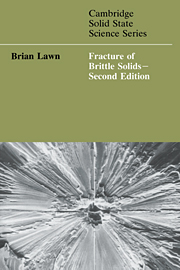Book contents
- Frontmatter
- Contents
- Preface
- Glossary of symbols and abbreviations
- 1 The Griffith concept
- 2 Continuum aspects of crack propagation I: linear elastic crack-tip field
- 3 Continuum aspects of crack propagation II: nonlinear crack-tip field
- 4 Unstable crack propagation: dynamic fracture
- 5 Chemical processes in crack propagation: kinetic fracture
- 6 Atomic aspects of fracture
- 7 Microstructure and toughness
- 8 Indentation fracture
- 9 Crack initiation: flaws
- 10 Strength and reliability
- References and reading list
- Index
9 - Crack initiation: flaws
Published online by Cambridge University Press: 14 January 2010
- Frontmatter
- Contents
- Preface
- Glossary of symbols and abbreviations
- 1 The Griffith concept
- 2 Continuum aspects of crack propagation I: linear elastic crack-tip field
- 3 Continuum aspects of crack propagation II: nonlinear crack-tip field
- 4 Unstable crack propagation: dynamic fracture
- 5 Chemical processes in crack propagation: kinetic fracture
- 6 Atomic aspects of fracture
- 7 Microstructure and toughness
- 8 Indentation fracture
- 9 Crack initiation: flaws
- 10 Strength and reliability
- References and reading list
- Index
Summary
All discussions on the strength of brittle solids in the preceding chapters are predicated on the existence of flaws. But what are the underlying origin and nature of such flaws? What flaw geometry and material parameters govern the micromechanics of initiation into the ultimate well-developed crack? How do persistent nucleation forces influence the stability of flaws during initiation and subsequent development?
The decades following 1920 witnessed a preoccupation of silicate-glass researchers with the search for ‘Griffith’ flaws. But observing such flaws by any direct means proved elusive. Typically, characteristic flaw dimensions in these and other homogeneous covalent–ionic solids like monocrystalline silicon, sapphire and quartz range from 1 nm (pristine fibres and whiskers) to 1 μm (aged, as-handled solids), and usually occur at the surface. As we indicated in sect. 1.6, planar defects on this scale are likely to lie below the limit of detectability by optical means. More recently, with the advent of modern heterogeneous polycrystalline ceramics, we have seen a shift in focus to microstructural fabrication flaws, the existence and character of which can be all too obvious. These latter range from 1 μm (high-density, fine-grained, polished materials) to 1 mm and above (refractories, concrete), and occur in both the surface and the bulk.
The small scale of typical flaws highlights the sensitivity of brittle solids to seemingly innocuous extraneous events and treatments (recall the one-hundred-fold reduction in strength on aging glass fibres, sect. 1.6).
- Type
- Chapter
- Information
- Fracture of Brittle Solids , pp. 307 - 334Publisher: Cambridge University PressPrint publication year: 1993
- 3
- Cited by



